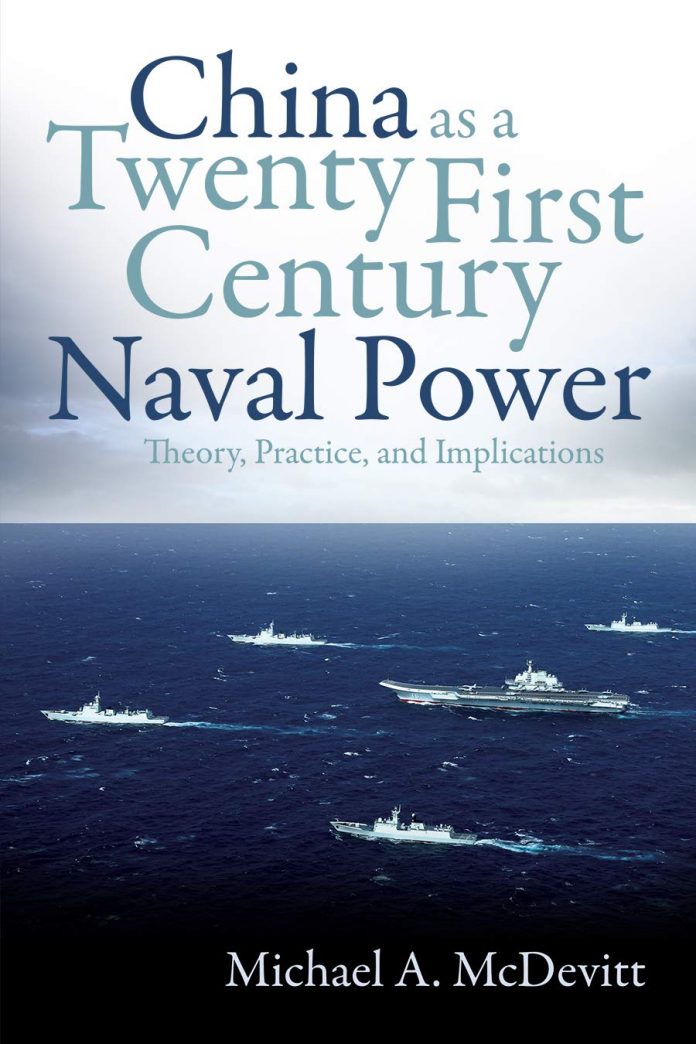
China as a Twenty-First Naval Power. By Michael A McDevitt. Naval Institute Press, Annapolis, 2020
Reviewed by Tim Coyle
The exponential growth of the People’s Liberation Army – Navy (PLAN) over the last 20 years may be contrasted with that of the Imperial German Navy 1895 to 1914. Germany, a major European land power, built a fleet which many British observers derisively referred to as a ‘luxury fleet’. Gestated and nurtured by Grand Admiral Tirpitz with the enthusiastic obsession of Kaiser Wilhelm II, the High Seas Fleet engaged the imperious Royal Navy in a ‘close run thing’ at sea, only to disintegrate in mutiny and ignominy.
Here the comparison ends as the PLAN is an exemplar of methodical, thoughtful and patient observation and learning from established maritime powers – predominately the US. While Wilhelm’s impetuosity built a fleet which – with the exception of the U-boat arm – was largely confined to the North Sea, China’s naval and maritime para-military forces are inexorably moving outwards – beyond the Nine-Dash Line and the Second Island Chain into a worldwide operational capability.
In China as a 21st Century Naval Power, Rear Admiral Michael McDevitt USN (Ret) provides a professional, dispassionate and wholly realistic assessment of China’s maritime strategy and capabilities. Extensively researched, the book is not only a masterwork on the PLAN but also includes equally forensic examinations of China’s associated maritime para-military forces – the China Coast Guard and the China Maritime Militia, written by specialists in this field – Ryan Martinson, Andrew Erickson and Connor Kennedy.
Regardless of western opinion on the political philosophy of the Chinese Communist Party and its leaders, the architecture of China’s maritime strategy is breathtakingly comprehensive and mature, arguably rivalling that of the great naval powers of recent history. China has not only a powerful navy – now rivalling the US Navy in size and modernity in platform design – it has the world’s largest coast guard and an enormous People’s Maritime Militia, both organisations substantial force multipliers and expert practitioners of ‘grey zone’ operations. These are coupled with an efficient merchant marine and an impressive shipbuilding capacity. These assets starkly point towards a global Chinese presence at sea.
McDevitt explains how the PLAN developed, where its future directions lie and its role in defending and supporting China’s interests. The book examines Chinese command and control arrangements, anti-access/area-denial strategy and how the PLAN surface, subsurface and air assets fit into the joint Chinese military strategy against the US.
The PLAN”s obsession is Sea Lines of Communication security, in particular the Indian Ocean which would stretch resources even for a fully developed blue water capability. The South China Sea is a different proposition due to China’s long term and ruthless annexation of islets on which it has constructed military facilities. Consequently, Chinese hegemony in the South China Sea is secure with its naval and maritime para-military capabilities deployable with short logistics chains. With these assets China can dominate and deter rival interests attempting to exert their perceived rights -from fishing to minerals exploration.
McDevitt concludes the future PLAN will have a global expeditionary capability with a powerful regional presence, able to dominate the near region by confronting the US and allied/partnerships such as the currently embryonic Quad, comprising the US, Japan, India and Australia. Whether other affected South East Asian countries bordering and claiming interests in the South China Sea and beyond will join the Quad in a form of loose partnership remains to be seen. Regional diplomacy to bring these nations together is now a priority. The opportunities to ‘contain China’ are long past and so is the ‘rules-based order’, which China has successfully flouted.
China as a 21st Century Naval Power is a landmark stand-alone assessment of an undoubtedly powerful maritime force. It should be recommended reading for maritime practitioners, policy-makers and strategic realists.



